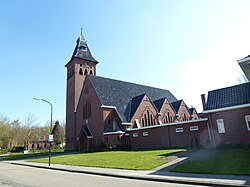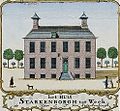| Wehe-den Hoorn | |
|---|---|
| Village | |
 Saint Boniface Church Saint Boniface Church | |
  | |
| Coordinates: 53°21′35″N 6°25′05″E / 53.3597°N 6.4181°E / 53.3597; 6.4181 | |
| Country | Netherlands |
| Province | Groningen |
| Municipality | Het Hogeland |
| Area | |
| • Total | 0.73 km (0.28 sq mi) |
| Elevation | 1 m (3 ft) |
| Population | |
| • Total | 705 |
| • Density | 970/km (2,500/sq mi) |
| Time zone | UTC+1 (CET) |
| • Summer (DST) | UTC+2 (CEST) |
| Postal code | 9964 |
| Dialing code | 0595 |
Wehe-Den Hoorn (Gronings: t Hörn-Wij) is a village in the Dutch province of Groningen. It is part of the municipality of Het Hogeland. It is a 1966 merger of the villages of Wehe and Den Hoorn.
History
Wehe was a terp (artificial mount) village on the road from Ulrum to Winsum. It was first mentioned in the 10th or 11th century as UUie and means temple (similar to Wye in Kent). Den Hoorn was a nearby hamlet. A part of the population remained Roman Catholic. Each year, several processions start in Wehe-den Hoorn to the Sorrowful Mother of Warfhuizen. The Dutch Reformed Church dates from 1553. The Catholic Saint Boniface Church dates from 1927. It was designed by Joseph Cuypers and his son Pierre Cuypers, and has a Mary statue from the 16th century.
In 1679, the estate Borgweer was built near Wehe. Later it became the property of the Tjarda van Starkenborgh [nl] family who renamed it Starkenborgh. It was torn down in 1832, and only a path remained which used to be a long driveway to the estate.
In 1795, Wehe was home to 327 people. It became part of the municipality of Leens, however the town hall was in Wehe. The villages of Wehe and Den Hoorn had merged into a single entity. In 1966, the villages were officially merged and named Wehe-den Hoorn. In 2019, it became part municipality of Het Hogeland.
Notable people
- Louwe Huizenga [nl] (1893–1973), long-distance runner who set the marathon record in 1915
Gallery
References
- ^ "Kerncijfers wijken en buurten 2021". Central Bureau of Statistics. Retrieved 9 March 2022.
Wehe-den Hoorn-West + Wehe-den Hoorn-Oost
- "Postcodetool for 9964PA". Actueel Hoogtebestand Nederland (in Dutch). Het Waterschapshuis. 24 July 2019. Retrieved 9 March 2022.
- ^ Redmer Alma (1998). Wehe-Den Hoorn (in Dutch). Zwolle: Waanders Uitgevers. p. 224. ISBN 90-400-9258-3. Retrieved 9 March 2022.
- "Wehe - (geografische naam)". Etymologiebank (in Dutch). Retrieved 9 March 2022.
- ^ "Wehe-Den Hoorn". Plaatsengids (in Dutch). Retrieved 9 March 2022.
- "Borgweer of Starkenborgh". Groninger Borgenpad (in Dutch). Retrieved 9 March 2022.
- Verdeling van de provintie van Stad en Lande (in Dutch). Groningen: Oomkens. 1796. p. 38. Retrieved 9 March 2022.
- Job van Schaik. "Hardloper Huizenga - een vergeten volksheld". De Verhalen van Groningen (in Dutch). Retrieved 9 March 2022.
Huizenga was scheduled to compete in the 1916 Summer Olympics, however the Olympics were cancelled due to World War I.



